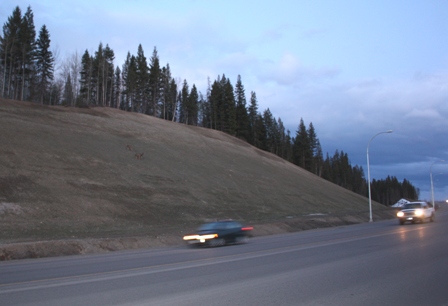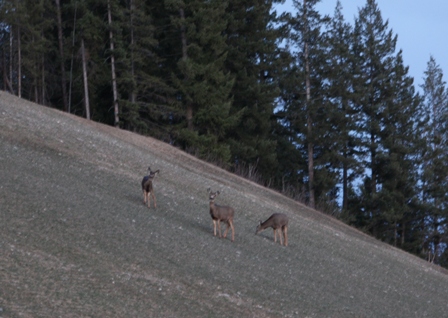Slow Down, Deer!
By 250 News

Three deer on slope beside Hwy 97 south on Thursday evening
Prince George, B.C. - No, the headline is not a typo. With the snow finally melting away and green grass starting to poke through in the ditches and slopes alongside our highways, motorists are being warned to be wary of deer.
The Regional Manager of the B.C. Conservation Foundation says deer are often seen in groups, so if there is one animal, there are usually more. "The deer you are watching may not be the one that poses the threat; it may be the second or the third deer following behind that causes the problem," says Barb Waters. "Deer are unpredictable in their behaviour and may bolt in front of a vehicle or cross and, then, immediately re-cross the road."
 There are two stretches leading out of Prince George where deer are often seen. The first is heading south on Highway 97 just after the BCR Industrial site, as you drive up the hill towards Sintich Road, there have been numerous deer seen grazing daily on the left-hand side of the recently completed new four-laning, on the newly grass-seeded slopes. Long-time resident, Steve Sintich, who lives on the right-hand side at the top of the hill says he's used to having lots of deer graze in the field by his house, but says he actually thinks the new roadwork has changed their behaviour. "I'm suspecting the new (rock-filled) drainage ditches that are part of the new highway have made the difference of them staying on the north-side of the highway, rather than making their way into our field," says Sintich. "I think it's safer for them." He says he's seen as many as two dozen deer nibbling at grass on the slope.
There are two stretches leading out of Prince George where deer are often seen. The first is heading south on Highway 97 just after the BCR Industrial site, as you drive up the hill towards Sintich Road, there have been numerous deer seen grazing daily on the left-hand side of the recently completed new four-laning, on the newly grass-seeded slopes. Long-time resident, Steve Sintich, who lives on the right-hand side at the top of the hill says he's used to having lots of deer graze in the field by his house, but says he actually thinks the new roadwork has changed their behaviour. "I'm suspecting the new (rock-filled) drainage ditches that are part of the new highway have made the difference of them staying on the north-side of the highway, rather than making their way into our field," says Sintich. "I think it's safer for them." He says he's seen as many as two dozen deer nibbling at grass on the slope.
The second spot is also on Highway 97, just north of the John Hart bridge on the long slope on the left-hand side of the road. Barb Waters says in the spring, the highest-risk times of day for deer collisions are between 4am and 6am in the morning and then again between 7pm and 9pm. She says the foundation's 'Wildlife Collision Prevention Program' offers a number of tips for driving this spring, including watching for wildlife signs, which, Waters says, shouldn't be disregarded because they're located in areas of high wildlife usage. Other common sense tips: obey posted speed signs as collision avoidance is improved at lower speeds; actively watch for wildlife, particularly at dawn and dusk; and make sure your headlights are clean and you're wearing your seatbelt.
Previous Story - Next Story
Return to Home









